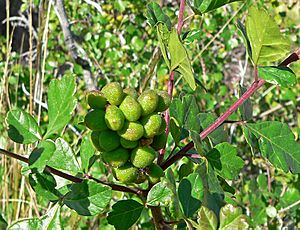Rhus trilobata facts for kids
Quick facts for kids Rhus trilobata |
|
|---|---|
 |
|
| Green berries | |
| Scientific classification | |
| Genus: |
Rhus
|
| Species: |
trilobata
|
Rhus trilobata, also known as skunkbush sumac or three-leaf sumac, is a type of shrub. It belongs to the sumac family. This plant grows naturally in western Canada and the Western United States. You can find it from the Great Plains all the way to California and south into northern Mexico. It grows in many different places, from hot deserts to cool mountain tops, even as high as about 2,134 meters (7,000 feet).
Contents
Where Does Skunkbush Sumac Grow?
Rhus trilobata grows in many different natural areas. These include grasslands, mountain shrublands, and various types of forests. You can also find it in wetlands, oak woodlands, and chaparral. This plant is very tough. If a wildfire burns the plant above ground, it usually grows back quickly. The fire rarely kills the entire plant.
What Does Skunkbush Sumac Look Like?
This sumac plant looks a lot like other sumac types. Its leaves have three small parts, called "leaflets." Other plants with similar three-part leaves include Rhus aromatica from eastern North America. It also looks a bit like western poison-oak. Sometimes, its leaves and shape make it look like a small-leafed oak tree.
Smell and Appearance
The leaves of Rhus trilobata have a very strong smell when you crush them. Some people think the smell is like medicine or is a bit bitter. It can be strong enough that the plant is called "skunkbush." When the leaves are new, they are green. In the fall, they turn orange and brown. The young branches are fuzzy, but they become smooth as they get older.
Flowers and Fruit
The flowers of the skunkbush sumac are white or light yellow. They grow on small clusters called "catkins." The plant also produces edible fruit. These are small, red berries that are a bit hairy and sticky. They smell a little like limes and taste very sour. This sour taste comes from natural acids like tannic and gallic acids.
How Skunkbush Sumac Reproduces
Animals help pollinate the flowers of the skunkbush sumac. The seeds are spread when animals eat the berries. The plant can also grow new plants from its roots. It sends up new shoots several meters away, forming thick patches of shrubs.
How People and Animals Use Skunkbush Sumac
The berries of the skunkbush sumac are an important food source. Many birds and small mammals eat them, especially in winter.
Traditional Uses by Native Americans
Native American tribes have used skunkbush sumac for many years.
- Medicine: The bark was chewed or made into a drink for cold symptoms. People ate the berries for stomach problems and toothaches. Leaves and roots were boiled and eaten for various health issues. The leaves were also sometimes smoked.
- Crafts: The flexible branches were very useful for making baskets and rugs.
- Food: The berries are sour but can be eaten. They were baked into bread or mixed into porridge or soup. When steeped in water, they make a tart drink similar to lemonade. You can also eat the fruit directly, and some people add a little salt to make it taste better. Marvin Johnson Jr., a Mono native, said that if you dry the fruit, it can last all year. You just add a little moisture when you want to eat them.
The Zuni people, Navajo, Mono tribe of California, and other tribes used the stems to make baskets. They would remove the bark first. The Uncompahgre Ute people call the berries mah wup and the bush ece.
Modern Uses
Today, skunkbush sumac is sometimes planted to help stop erosion of soil. It is also used in landscaping. This plant is helpful for bringing life back to land that has been damaged by mining.

